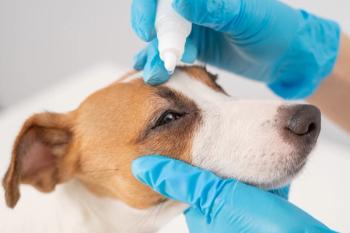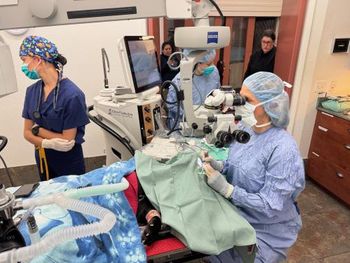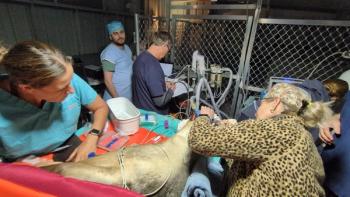
Techniques for useful interpretation of the small animal fundus (Proceedings)
Some of the most common fundic abnormalities result from ocular fungal disease such as blastomycosis, but cryptococosis, histoplasmosis and coccidiomycosis also may cause a variety of retinal changes.
Direct fundic exam
- Start 1.5-2" away at 0 D setting and rotate wheel toward negative (red) until fundus near disk is visible—usually about a -2 setting
- Examine fundus in quadrants
- Re-focus to evaluate optic disk
- Usually within 1D of fundus focus, more neg. means disc depression, more pos. is elevation
- Advantages: simple, inexpensive instrument, upright image, greater magnification, depth and height can be determined with variable diopter settings
Indirect ophthalmoscopy
Ophthalmoscopes—Ophthalmologists prefer binocular indirect ophthalmoscopy for larger field of view and depth perception—in addition to lower magnification.
Lenses-most common condensing lenses are 2.2 panretial, 20D and 28D. Smaller diopter rating=greater magnification They produce a virtual image.
The lens is held at arms length and an organized approach is used to view the entire fundus. Smaller diopter rating=greater magnification
Light source can be from trans-illuminator held near examiner's eye or from binocular indirect system
Image is inverted with R-L reversal or "upside down and backwards"
Optic Nerve and retinal vascularture are viewed in 4 quadrants. Optic nerve heads vary greatly with all species due to variations in myelin. Tapetal and nontapetal fundus also can vary-especially due to degree of albinism. Vasculature will also vary greatly by species as well as within the same species.
Common fundus abnormalities
Some of the most common fundic abnormalities result from ocular fungal disease such as blastomycosis, but cryptococosis, histoplasmosis and coccidiomycosis also may cause a variety of retinal changes. Toxoplasmosis is commonly associated with retinal lesions.
Other causes of variations in retinal appearance include Collie Eye Anomaly (CEA) and retinal detachment that can result from a multitude of underlying causes such as congenital, trauma, metabolic, infectious and neoplastic. Progressive Retinal Atrophy is a common cause degenerative changes and glaucoma can result in optic nerve head cupping.
Electrinoscopy testing and equipment
Requires a photostimulator and computer to record the waveform that corresponds to eletromagnetic potential of photoreceptors, and Muller cells. Performed routinely prior to cataract surgery. Used to differentiate optic neuritis from Sudden Aquired Retinal Degeneration (SARDs)
Other variations in the fundus include choroidal hypoplasia as seen in Collie Eye Anomoly. Coloboma of the optic nerve head is also seen in some dogs with CEA but can occur in any species. Retinal detachment may also be a sequlae to CEA.
Chorioretinitis results from infectious causes such as all of the ocular mycotic diseases. Images of Coccidimycosis, Cryptococcosis, and Histoplasmosis will be reviewed.
Causes of pre-retinal hemorrhage include rickettsial/tick bourne disease. Multifocal hyperreflective lesions may occur as well pigment proliferation.
Lipemic retinalis results in a very characteristic vasculature color change.
Examples of Progressive Retinal Atrophy will be shown. Classic changes are a result of tapetal thinning, vessel attenuation and optic nerve head atrophy. Irreversible—waveform is extinguished.
Sudden Aquired Retinal Degeneration. The retina may appear normal or abnormal but the ERG waveform is always extinguished. Early work is studying the effect of an immunoglobulin for treatment of limited,early cases of SARDs where the fundus appears normal. Limited vision recovery has been reported-but is in the very early stages of development.
Images of retinal hemorrhages, dysplasia, folds and detachments will be discussed.
Common etiologies of retinal detachment include vtreal deneration that is commonly seen in Shih tsu, Boston Terrier, and poodles. Other causes include post intraocular surgery,ie (cataract removal and lens luxation) and hypertension. Retinal dysplasia most commonly noted in Labrador retriever and Springer Spaniels.
Retinal reattachment surgery has become a successful procedure in Veterinary Ophthalmology. Laser and endolaser use has greatly improved postoperative success rates.
Newsletter
From exam room tips to practice management insights, get trusted veterinary news delivered straight to your inbox—subscribe to dvm360.




